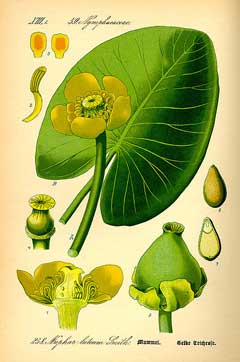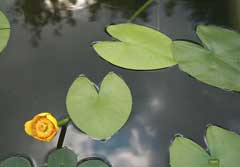 |
|
http://commons.wikimedia.org/wiki/File:Illustration_Nuphar_lutea0.jpg |
 |
|
Translate this page:
Summary
Physical Characteristics
![]()
![]() Nuphar lutea is a PERENNIAL.
Nuphar lutea is a PERENNIAL.
See above for USDA hardiness. It is hardy to UK zone 4. It is in flower from June to August, and the seeds ripen from August to September. The species is hermaphrodite (has both male and female organs) and is pollinated by Flies, beetles.
Suitable for: light (sandy), medium (loamy) and heavy (clay) soils. Suitable pH: mildly acid, neutral and basic (mildly alkaline) soils. It can grow in semi-shade (light woodland) or no shade. It can grow in water.
UK Hardiness Map
US Hardiness Map
Synonyms
Nymphaea lutea.
Plant Habitats
Pond;
Edible Uses
Edible Parts: Leaves Root Seed
Edible Uses: Drink
Root - cooked[2, 46, 61, 177, 183]. An edible starch can be extracted from the root[183]. A possible emergency food[61]. The root has a bitter flavour - this bitterness can be removed by leaching the root in water[K]. Leaves and leaf stalks - cooked[2, 177, 183]. Seed - cooked[105]. It can be ground into a powder and used in making bread and porridge, or for thickening soups etc[207]. The seed can also be parched, when it swells considerably but does not burst like popcorn[183]. It is then normally eaten dry[207]. A refreshing drink is made from the flowers[2, 183].
References More on Edible Uses
Medicinal Uses
Plants For A Future can not take any responsibility for any adverse effects from the use of plants. Always seek advice from a professional before using a plant medicinally.
Anaphrodisiac Anodyne Antiscrophulatic Antispasmodic Astringent Cardiotonic Demulcent Hypotensive
Sedative Vasoconstrictor
The roots are anaphrodisiac, anodyne, antiscrofulatic, astringent, cardiotonic, demulcent and sedative[4]. Caution should be exercised because large doses are potentially toxic[222]. A tea made from the roots is used in the treatment of 'sexual irritability', blood diseases, chills etc[4, 222]. The root is poulticed and applied to swellings, inflammations, cuts etc[4, 222]. The root contains steroids and is a folk remedy for infertility[222]. Alkaloids in the root are reportedly hypotensive, antispasmodic, cardiac, tonic and vasoconstrictor[222].
References More on Medicinal Uses
The Bookshop: Edible Plant Books
Our Latest books on Perennial Plants For Food Forests and Permaculture Gardens in paperback or digital formats.

Edible Tropical Plants
Food Forest Plants for Hotter Conditions: 250+ Plants For Tropical Food Forests & Permaculture Gardens.
More

Edible Temperate Plants
Plants for Your Food Forest: 500 Plants for Temperate Food Forests & Permaculture Gardens.
More

More Books
PFAF have eight books available in paperback and digital formats. Browse the shop for more information.
Shop Now
Other Uses
References More on Other Uses
Cultivation details
A water plant requiring a rich soil and a sunny position[1, 56]. Succeeds in light shade[200]. It is best grown in still water up to 250cm deep but it also tolerates slow moving water[200]. Prefers shallow water[1]. Plants are hardy to about -20°c[187]. The flowers have a sickly scent[188]. The flowers have a brandy-like scent[245]. This unique smell is due to a combination of acetic acid and ethyl alcohol to form ethylacetate[245].
References Carbon Farming Information and Carbon Sequestration Information
Temperature Converter
Type a value in the Celsius field to convert the value to Fahrenheit:
Fahrenheit:
The PFAF Bookshop
Plants For A Future have a number of books available in paperback and digital form. Book titles include Edible Plants, Edible Perennials, Edible Trees,Edible Shrubs, Woodland Gardening, and Temperate Food Forest Plants. Our new book is Food Forest Plants For Hotter Conditions (Tropical and Sub-Tropical).
Shop Now
Plant Propagation
Seed - sow as soon as it is ripe in a greenhouse in pots submerged under 25mm of water. Prick out into individual pots as soon as the first true leaf appears and grow them on in water in a greenhouse for at least two years before planting them out in late spring. The seed is collected by wrapping the developing seed head in a muslin bag to avoid the seed being lost. Harvest it 10 days after it sinks below the soil surface or as soon as it reappears[200]. Division in May. Each portion must have at least one eye. Submerge in pots in shallow water until established[56].
Other Names
If available other names are mentioned here
Native Range
TEMPERATE ASIA: Iran (north), Israel, Lebanon, Syria, Turkey, Russian Federation-Ciscaucasia (Ciscaucasia), Armenia, Azerbaijan, Georgia, Russian Federation-Western Siberia (Western Siberia), Russian Federation-Eastern Siberia (Eastern Siberia), Kazakhstan (west), China (Xinjiang Uygur Zizhiqu) EUROPE: Denmark, Finland, United Kingdom, Ireland, Norway, Sweden, Austria, Belgium, Switzerland, Czech Republic, Germany, Hungary, Netherlands, Poland, Slovakia, Russian Federation (European part), Belarus, Estonia, Lithuania, Latvia, Moldova, Ukraine, Albania, Bulgaria, Bosnia and Herzegovina, Greece (north), Croatia, Italy (incl. Sardinia), North Macedonia, Montenegro, Romania, Serbia, Slovenia, Spain, France, Portugal AFRICA: Algeria (north)
Weed Potential
Right plant wrong place. We are currently updating this section.
Please note that a plant may be invasive in one area but may not in your area so it's worth checking.
Conservation Status
IUCN Red List of Threatened Plants Status :

Growth: S = slow M = medium F = fast. Soil: L = light (sandy) M = medium H = heavy (clay). pH: A = acid N = neutral B = basic (alkaline). Shade: F = full shade S = semi-shade N = no shade. Moisture: D = dry M = Moist We = wet Wa = water.
Now available:
Food Forest Plants for Mediterranean Conditions
350+ Perennial Plants For Mediterranean and Drier Food Forests and Permaculture Gardens.
[Paperback and eBook]
This is the third in Plants For A Future's series of plant guides for food forests tailored to
specific climate zones. Following volumes on temperate and tropical ecosystems, this book focuses
on species suited to Mediterranean conditions—regions with hot, dry summers and cool, wet winters,
often facing the added challenge of climate change.
Read More
Expert comment
Author
(L.)Sm.
Botanical References
17200
Links / References
For a list of references used on this page please go here
Readers comment
© 2010, Plants For A Future. Plants For A Future is a charitable company limited by guarantee, registered in England and Wales. Charity No. 1057719, Company No. 3204567.